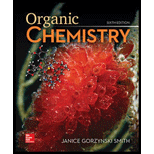
(a)
Interpretation: All constitutional isomers formed in the given elimination reaction is to be drawn and the mechanism to be labeled as E2 or E1.
Concept introduction: Constitutional isomers have the same molecular formula but they differ in the pattern in which atoms are connected. In the reaction of a halide with base the product formed depends on the type of halide and the base employed.
(b)
Interpretation: All constitutional isomers formed in the given elimination reaction is to be drawn and the mechanism to be labeled as E2 or E1.
Concept introduction: Constitutional isomers have the same molecular formula but they differ in the pattern in which atoms are connected. In the reaction of a halide with base the product formed depends on the type of halide and the base employed.
(c)
Interpretation: All constitutional isomers formed in the given elimination reaction is to be drawn and the mechanism to be labeled as E2 or E1.
Concept introduction: Constitutional isomers have the same molecular formula but they differ in the pattern in which atoms are connected. In the reaction of a halide with base the product formed depends on the type of halide and the base employed.
(d)
Interpretation: All constitutional isomers formed in the given elimination reaction is to be drawn and the mechanism to be labeled as E2 or E1.
Concept introduction: Constitutional isomers have the same molecular formula but they differ in the pattern in which atoms are connected. In the reaction of a halide with base the product formed depends on the type of halide and the base employed.
(e)
Interpretation: All constitutional isomers formed in the given elimination reaction is to be drawn and the mechanism to be labeled as E2 or E1.
Concept introduction: Constitutional isomers have the same molecular formula but they differ in the pattern in which atoms are connected. In the reaction of a halide with base the product formed depends on the type of halide and the base employed.
(f)
Interpretation: All constitutional isomers formed in the given elimination reaction is to be drawn and the mechanism to be labeled as E2 or E1.
Concept introduction: Constitutional isomers have the same molecular formula but they differ in the pattern in which atoms are connected. In the reaction of a halide with base the product formed depends on the type of halide and the base employed.
Trending nowThis is a popular solution!

Chapter 8 Solutions
ORGANIC CHEMISTRY (LOOSELEAF)
- о но оarrow_forwardName the major organic product of the following action of 4-chloro-4-methyl-1-pentanol in neutral pollution 10+ Now the product. The product has a molecular formula f b. In a singly hain, the starting, material again converts into a secule with the molecular kormula CIO. but with comply Draw the major organic structure inhalationarrow_forwardMacmillan Learning Alcohols can be oxidized by chromic acid derivatives. One such reagent is pyridinium chlorochromate, (C,H,NH*)(CICTO3), commonly known as PCC. Draw the proposed (neutral) intermediate and the organic product in the oxidation of 1-butanol by PCC when carried out in an anhydrous solvent such as CH₂C₁₂. PCC Intermediate OH CH2Cl2 Draw the intermediate. Select Draw Templates More с H Cr о Product Draw the product. Erase Select Draw Templates More H о Erasearrow_forward
- If I have 1-bromopropene, to obtain compound A, I have to add NaOH and another compound. Indicate which compound that would be. A C6H5 CH3arrow_forwardProvide the reagents for the following reactions.arrow_forwardIf I have 1-bromopropene, to obtain compound Z, I have to add two compounds A1 and A2. Indicate which compounds are needed. P(C6H5)3arrow_forward
- Draw the major product of this reaction. Ignore inorganic byproducts. Assume that the water side product is continuously removed to drive the reaction toward products. O CH3CH2NH2, TSOH Select to Draw >arrow_forwardPredict the major organic product(s) for the following reaction.arrow_forwardPredict the major organic product(s) for the following reactions.arrow_forward
- Provide the complete mechanism for the reactions below. You must include appropriate arrows,intermediates, and formal charges.arrow_forwardIndicate the products obtained by reacting fluorobenzene with a sulfonitric mixture.arrow_forwardIf I have 1-bromopropene, to obtain compound A, I have to add NaOH and another compound. Indicate which compound that would be. C6H5 CH3arrow_forward
 ChemistryChemistryISBN:9781305957404Author:Steven S. Zumdahl, Susan A. Zumdahl, Donald J. DeCostePublisher:Cengage Learning
ChemistryChemistryISBN:9781305957404Author:Steven S. Zumdahl, Susan A. Zumdahl, Donald J. DeCostePublisher:Cengage Learning ChemistryChemistryISBN:9781259911156Author:Raymond Chang Dr., Jason Overby ProfessorPublisher:McGraw-Hill Education
ChemistryChemistryISBN:9781259911156Author:Raymond Chang Dr., Jason Overby ProfessorPublisher:McGraw-Hill Education Principles of Instrumental AnalysisChemistryISBN:9781305577213Author:Douglas A. Skoog, F. James Holler, Stanley R. CrouchPublisher:Cengage Learning
Principles of Instrumental AnalysisChemistryISBN:9781305577213Author:Douglas A. Skoog, F. James Holler, Stanley R. CrouchPublisher:Cengage Learning Organic ChemistryChemistryISBN:9780078021558Author:Janice Gorzynski Smith Dr.Publisher:McGraw-Hill Education
Organic ChemistryChemistryISBN:9780078021558Author:Janice Gorzynski Smith Dr.Publisher:McGraw-Hill Education Chemistry: Principles and ReactionsChemistryISBN:9781305079373Author:William L. Masterton, Cecile N. HurleyPublisher:Cengage Learning
Chemistry: Principles and ReactionsChemistryISBN:9781305079373Author:William L. Masterton, Cecile N. HurleyPublisher:Cengage Learning Elementary Principles of Chemical Processes, Bind...ChemistryISBN:9781118431221Author:Richard M. Felder, Ronald W. Rousseau, Lisa G. BullardPublisher:WILEY
Elementary Principles of Chemical Processes, Bind...ChemistryISBN:9781118431221Author:Richard M. Felder, Ronald W. Rousseau, Lisa G. BullardPublisher:WILEY





